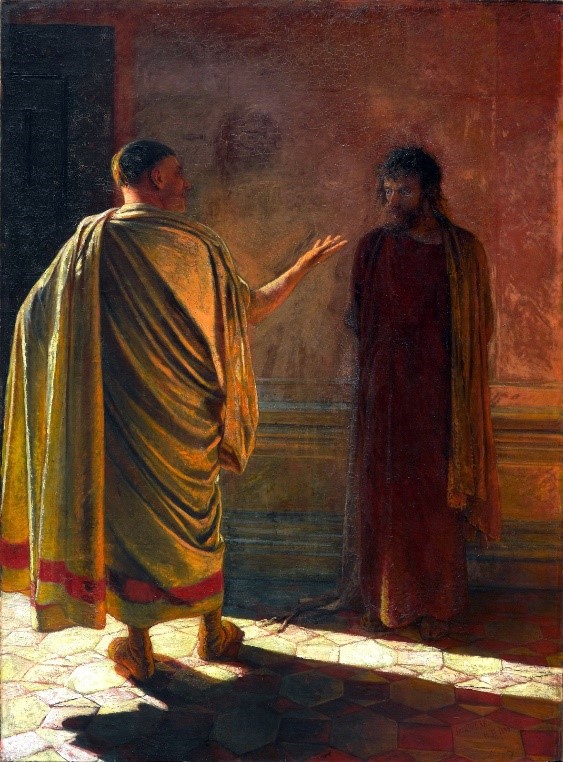John 18:33-38
33 Pilate therefore entered again into the Praetorium, called Jesus, and said to him, “Are you the King of the Jews?” 34 Jesus answered him, “Do you say this by yourself, or did others tell you about me?”
35 Pilate answered, “I’m not a Jew, am I? Your own nation and the chief priests delivered you to me. What have you done?” 36 Jesus answered, “My Kingdom is not of this world. If my Kingdom were of this world, then my servants would fight, that I wouldn’t be delivered to the Jews. But now my Kingdom is not from here.” 37 Pilate therefore said to him, “Are you a king then?” Jesus answered, “You say that I am a king. For this reason I have been born, and for this reason I have come into the world, that I should testify to the truth. Everyone who is of the truth listens to my voice.” 38 Pilate said to him, “What is truth?”
Shortly after its creation, this painting by the Russian realist Nikolai Ge was banned on account of blasphemy. It was hated by critics and met with confusion by many people. Ge, a scientist-turned-artist interested in realism and thorough research, had his reasons for his artistic decisions; however, blasphemy was not one of them.
Jesus is beautiful to the Christian because He is the very incarnate image of our beautiful God and because He is perfect love, salvation, and truth. So many artists through the ages have chosen to show this spiritual truth as a physical reality and paint Jesus with soft, handsome features. But Ge paints Jesus very differently. Jesus is unkempt, coarse, and rather ugly. He is standing in the shadows which makes Him feel off-putting at best and menacing at worst. His hands are bound behind His back and His stance is not the usual gracious, elegant stance that Jesus is usually portrayed. It is cold and closed. By contrast, Pilate, the “villian” of the scene, is bathed in light, easy and elegant. The people who saw this painting were shocked by this reversal, this portrayal of Christ as ugly and unfriendly. Besides the fact that scripture does say that Christ was not especially physically attractive, perhaps what Ge was doing was showing how Jesus was seen by everyone present, particularly Pilate, in that moment right then and not by us centuries later. First of all, He was a common Jewish nobody; a poor homeless man from Galilee who had recently been causing a bit of a stir. He had gotten no sleep the night before in Gethsemane. He was just arrested and is currently being charged as a criminal. The way Jesus answers for Himself is rather cold and calm. He speaks matter of factly, not really offering more information or explanation than necessary. He knows the path He is on now and where it will lead. He was hated by the Jews at this point and Pilate seems to feel fairly ambivalent about Him; He doesn’t want to condemn Him but he doesn’t really defend Him that passionately either. Maybe he chalks it up to it a weird Jewish thing, foreign to him as a Roman. He dismisses his perplexing case with a “What is truth?” and walks away.
Doesn’t our world do that so often today? With their wisdom, power, fine clothes, and amenities, so many move about freely dismissing Jesus as not really bad but also not worth defending, resting in the “relativity” of truth. But truth is not relative. Jesus is the way, the truth, and the life; and that does not change even if He appears unimportant, foreign, confusing, and unattractive.
Located in Tretyakov Gallery, Moscow
Want to see more? Like, follow & share… https://www.facebook.com/comemeetjesus.art
Buy the coffee table book at https://www.comemeetjesus.art
